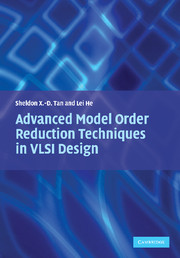Book contents
- Frontmatter
- Contents
- Figures
- Tables
- Foreword
- Acknowledgments
- 1 Introduction
- 2 Projection-based model order reduction algorithms
- 3 Truncated balanced realization methods for MOR
- 4 Passive balanced truncation of linear systems in descriptor form
- 5 Passive hierarchical model order reduction
- 6 Terminal reduction of linear dynamic circuits
- 7 Vector-potential equivalent circuit for inductance modeling
- 8 Structure-preserving model order reduction
- 9 Block structure-preserving reduction for RLCK circuits
- 10 Model optimization and passivity enforcement
- 11 General multi-port circuit realization
- 12 Reduction for multi-terminal interconnect circuits
- 13 Passive modeling by signal waveform shaping
- References
- Index
1 - Introduction
Published online by Cambridge University Press: 19 January 2010
- Frontmatter
- Contents
- Figures
- Tables
- Foreword
- Acknowledgments
- 1 Introduction
- 2 Projection-based model order reduction algorithms
- 3 Truncated balanced realization methods for MOR
- 4 Passive balanced truncation of linear systems in descriptor form
- 5 Passive hierarchical model order reduction
- 6 Terminal reduction of linear dynamic circuits
- 7 Vector-potential equivalent circuit for inductance modeling
- 8 Structure-preserving model order reduction
- 9 Block structure-preserving reduction for RLCK circuits
- 10 Model optimization and passivity enforcement
- 11 General multi-port circuit realization
- 12 Reduction for multi-terminal interconnect circuits
- 13 Passive modeling by signal waveform shaping
- References
- Index
Summary
The need for compact modeling of interconnects
As VLSI technology advances into the sub-100nm regime with increased operating frequency and decreased feature sizes, the nature of the VLSI design has changed significantly. One fundamental paradigm change is that parasitic interconnect effects dominate both the chip's performance and the design's complexity growth. As feature sizes become smaller, their electromagnetic couplings become more pronounced. As a result, their adverse impacts on circuit performances and powers will become more significant. Signal integrity, crosstalk, skin effects, substrate loss and digital and analog substrate couplings are now adding severe complications to design methodologies already stressed by increasing device counts. It was observed that today's high performance digital design essentially becomes analog circuit design [24] as there has been a need to observe a finer level of detail.
In addition to dominant deep submicron effects, the exponential increase of device counts causes a move in the opposite direction: we need to increase the increasing design abstraction levels to cope with the design capacity growth. It was widely believed that behavioral and compact modeling for the purpose of synthesis, optimization, and verification of the complicated system-on-a-chip are viable solutions to address these challenging design problems [66].
In this book, we focus on the compact modeling of on-chip interconnects and general linear time invariant systems (LTI) because interconnect parasitics, which are modeled as linear RLCM circuits, are the dominant factors for complexity growth.
- Type
- Chapter
- Information
- Publisher: Cambridge University PressPrint publication year: 2007



